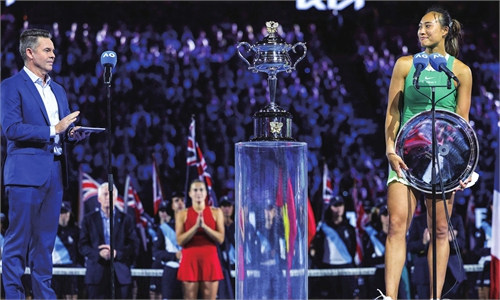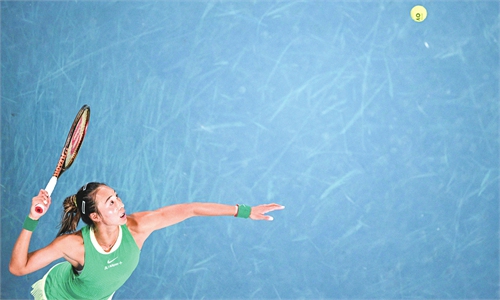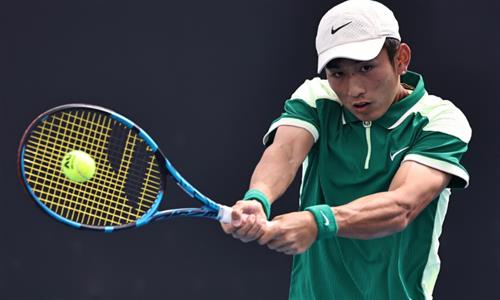SPORT / TENNIS
High hopes for Chinese tennis at Aussie Open

Illustration: Liu Xiangya/GT
The 2025 Australian Open is set to start on Sunday, with a remarkable 11-Chinese tennis player squad. Eight Chinese women, led by star Zheng Qinwen, and three Chinese men have earned direct entry into the singles main draw, with additional representation in doubles. Following a stellar 2024 for Chinese tennis, 2025's first Grand Slam has fueled anticipation for how these athletes will perform on one of the sport's biggest stages.
Zheng has become a household name in Chinese tennis, thanks to her consistent performances and growing accolades. After winning an Olympic gold medal in Paris and making it into the WTA Finals championship match in her debut of the tournament, Zheng has solidified her status as one of the most formidable players in the women's game. Entering the 2025 Australian Open, it is no exaggeration to say Zheng is one of the top contenders for the women's singles title.
However, professional tennis is an unpredictable arena, where even the brightest stars can face hurdles in delivering their best at every event.
Zheng faces a unique challenge this time, having skipped all lead-up tournaments to make a direct debut at the Australian Open. While this approach may have helped her stay physically fresh, it may also leave her at a slight disadvantage in terms of match rhythm. Nevertheless, her technical prowess, mental resilience, and experience in handling high-pressure situations make her a strong favorite to make a deep run in the tournament.
Zheng, a 2024 Australian Open finalist, is the second Chinese player after Li Na to reach a major final. She will start her campaign in 2025 as the fifth seed by taking on either a qualifier or lucky loser. She could face world No.1 Aryna Sabalenka in the quarterfinals, a rematch of 2024's final.
Another exciting prospect is Wang Xinyu, who has moved up to world No.37. Wang has shown significant improvement over the past two years, as she won a mixed doubles silver medal at the Olympics, demonstrating that she possesses the skill set to challenge top players and potentially progress to the latter stages of the competition.
Alongside Zheng and Wang, other Chinese women in the singles main draw include Zhu Lin, Wang Xiyu, and Yuan Yue, all of whom have shown glimpses of their capabilities on the WTA Tour. While their results may not have reached the same heights as Zheng, their presence in the tournament reflects the growing depth of Chinese women's tennis.
The Chinese men's contingent at the Australian Open also promises compelling performances. Zhang Zhizhen, who recently led China to the quarterfinals of the United Cup, leveling China's best result in the competition, has firmly established himself as the country's top male player. Facing several world-class opponents in that tournament, Zhang proved his mettle and capabilities, underlining his readiness for Grand Slam competition.
Zhang, who reached a career-high ATP ranking of No.31 in 2024, brings experience and determination to the Australian Open. With his aggressive baseline game and solid service motion, he has the tools to take on higher-ranked opponents and deliver a strong performance.
Hot on Zhang's heels is 19-year-old Shang Juncheng, whose meteoric rise in the rankings has put him within striking distance of Zhang's position as China's No.1 male player. In 2024, Shang made history by reaching the third round of the Australian Open - the best-ever result for a Chinese mainland male player in the tournament's history.
In preparation for 2025's event, Shang competed in the ATP Hong Kong Tennis Open, advancing to the semifinals, replicating his approach from last season. With his confidence soaring, Shang is poised to achieve even greater heights in Melbourne.
Another player to watch is Bu Yunchaokete, who has broken into the Grand Slam main draw for the first time through his improved ATP ranking into world top 100, thanks to a breakthrough performance during the tennis China swing in 2024.
Known for his calm demeanor and solid baseline play, Bu will face tough competition in Melbourne, but his inclusion in the main draw marks a significant milestone for both him and Chinese tennis. It also underscores the success of China's player development system, which is beginning to produce a steady stream of talent capable of competing at the sport's highest level.
However, challenges remain. The gap between Chinese players and the world's elite persists, particularly in consistently competing at the highest level. But every match against a top-ranked opponent provides invaluable experience. Even when they lose, these players learn to adapt to the physical intensity, tactical demands, and mental resilience required at the sport's pinnacle.
The increasing number of Chinese players at the Australian Open signals more than just a momentary surge, as it points to a broader trend of development in Chinese tennis. With a growing pool of talent, structured support systems and rising public interest, the sport is poised for sustained growth in the country.
The author is a reporter with the Global Times. life@globaltimes.com.cn



